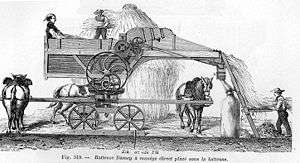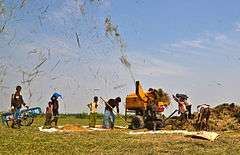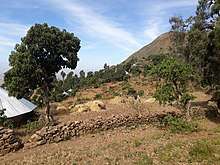Threshing
Threshing is the process of loosening the edible part of grain (or other crop) from the chaff to which it is attached. It is the step in grain preparation after reaping. Threshing does not remove the bran from the grain.[1]

Threshing may be done by beating the grain using a flail on a threshing floor. Another traditional method of threshing is to make donkeys or oxen walk in circles on the grain on a hard surface. A modern version of this in some areas is to spread the grain on the surface of a country road so the grain may be threshed by the wheels of passing vehicles.[2]
Hand threshing was laborious, with a bushel of wheat taking about an hour.[3] In the late 18th century, before threshing was mechanized[4], about one-quarter of agricultural labor was devoted to it.[5]
Industrialization of threshing began in 1786 with the invention of the threshing machine by Scotsman Andrew Meikle. Today, in developed areas, it is now mostly done by machine, usually by a combine harvester, which harvests, threshes, and winnows the grain while it is still in the field.[6][7]
The cereal may be stored in a barn or silos.
A threshing bee was traditionally a bee in which local people gathered together to pitch in and get the season's threshing done. Such bees were sometimes festivals or events within larger harvest festivals. Today the original purpose is largely obsolete, but the festival tradition lives on in some modern examples that commemorate the past and include flea markets, hog wrestling, and dances.[8][9][10]
Gallery
 Threshing with hand flails, Great Britain, c. 1750. Image from c. 1875.
Threshing with hand flails, Great Britain, c. 1750. Image from c. 1875. Threshing floor, Santorini, Greece
Threshing floor, Santorini, Greece Ludovic Bassarab's La treierat ("Threshing"), showing peasants in Romanian dress around a combine harvester
Ludovic Bassarab's La treierat ("Threshing"), showing peasants in Romanian dress around a combine harvester A farmer works on his field threshing with yolks in old age
A farmer works on his field threshing with yolks in old age Wheat Threshing Demo at Goessel Threshing Days in Goessel, Kansas, 2010.
Wheat Threshing Demo at Goessel Threshing Days in Goessel, Kansas, 2010. Threshing of paddy by machine, Bangladesh
Threshing of paddy by machine, Bangladesh
See also
| Look up threshing in Wiktionary, the free dictionary. |
| Wikimedia Commons has media related to Threshing. |
References
- "threshing".
- M. Partridge, Farm Tools through the Ages (1973)
- Atack, Jeremy; Passell, Peter (1994). A New Economic View of American History. New York: W.W. Norton and Co. pp. 282–3. ISBN 0-393-96315-2.
- "The Bob & Diane Miller Collection - Wheat Threshing (1993)". Texas Archive of the Moving Image. Retrieved November 19, 2019.
- Clark, Gregory (2007). A Farewell to Alms: A Brief Economic History of the World. Princeton University Press. p. 286. ISBN 978-0-691-12135-2.
- "Andrew Meikle (1719-1811) engineer and inventor of the threshing machine, the predecessor of the combine harvester". Scottish Engineering Hall of Fame. Retrieved 5 April 2015.
- "The Threshing Machine -- Separation of Grain from Stalks and Husks".
- "home".
- http://www.dufurthreshingbee.org
- "Welcome to the Donnelly Threshing Bee".
